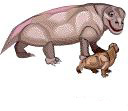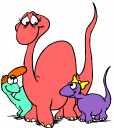
How Were Dinosaurs Like People?
|

|
|
Share This Page
|
|
|
|
|
|
|
Follow This Site

|
 |
|
|
|
|

|

 People
used to think that dinosaurs were big, lumbering animals who
were always involved in fights with each other. We've all
heard stories of the brave triceratops fighting against the
fierce Tyrannosaurus rex. Yes, dinosaurs did fight each
other and preyed on each other to survive.
People
used to think that dinosaurs were big, lumbering animals who
were always involved in fights with each other. We've all
heard stories of the brave triceratops fighting against the
fierce Tyrannosaurus rex. Yes, dinosaurs did fight each
other and preyed on each other to survive.
But
scientists are discovering more and more that dinosaurs were
less "dinosaur-like" than we thought. In fact, some
scientists now believe that dinosaurs behaved much like
mammals did and do. Mammals, of course, include
humans--people, just like you.
Here
are some ways that dinosaurs were like people:
 When baby dinosaurs were
born to many species, the mother and many times even the
father dinosaurs would stay with the babies in the nest,
protecting them from predators. Many species, of course,
left their babies to fend for themselves. But more and
more, scientists are finding evidence of parents
protecting babies in the nest.
When baby dinosaurs were
born to many species, the mother and many times even the
father dinosaurs would stay with the babies in the nest,
protecting them from predators. Many species, of course,
left their babies to fend for themselves. But more and
more, scientists are finding evidence of parents
protecting babies in the nest.- The same can be said
for feeding the baby dinosaurs. Many parents are thought
to have brought food back to the nest, instead of taking
the baby dinosaurs out on the hunt.
 Scientists also now think
that dinosaurs formed communities, or extended families.
Dinosaurs that had trouble protecting themselves from
predators traveled in large packs. A hungry meat-eating
dinosaur would be less likely to attack a herd of 30
plant-eating dinosaurs.
Scientists also now think
that dinosaurs formed communities, or extended families.
Dinosaurs that had trouble protecting themselves from
predators traveled in large packs. A hungry meat-eating
dinosaur would be less likely to attack a herd of 30
plant-eating dinosaurs.- This community idea
worked on the other side of the food chain, too.
Predators formed packs, to make the kill easier. One
predator against a family of 7 plant-eaters didn't have
much of a chance. But 4 or 5 predators against that same
family of 7 plant-eaters had a very good chance of
getting all the food they needed to survive.
These
are just some of the ways that dinosaurs were like people.
They protected and fed their young, and they formed
communities for protection and survival.
|
|